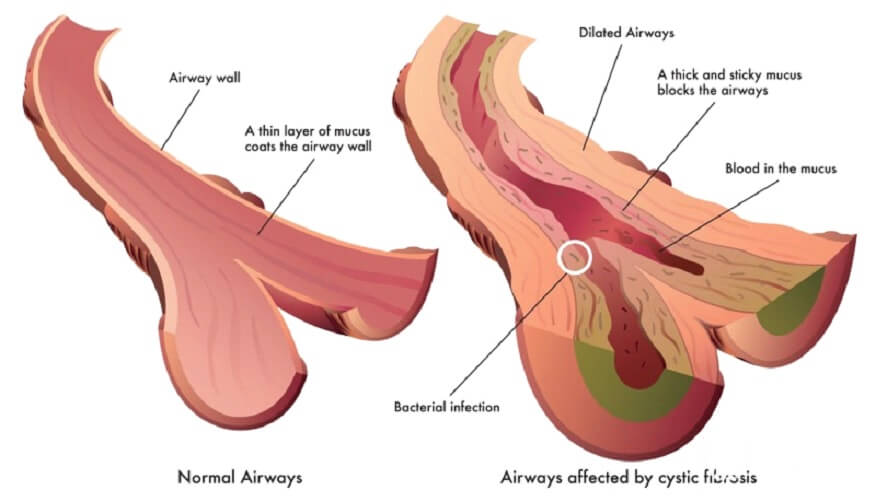CYSTIC FIBROSIS – MORE THAN AN AIRWAY DISEASE

Every May is Cystic Fibrosis Month. Cystic Fibrosis or CF is an inherited disease that affects every organ in the body not just the lungs.
There are now approximately 40,000 children and adults living with CF in the U.S. alone with about 1,000 new diagnoses each year.
Diagnosed early in children and now part of the newborn genetic screening, CF is a condition that results from a genetic deletion of the cystic fibrosis transmembrane conductance regulator (CFTR) or from a polymorphism that causes the CFTR protein to be dysfunctional.
The result is the inability to mobilize chloride in cells and chloride is a component of salt that regulates fluid balance and an electrical potential across cell membranes.
Consequently, patients get a build up of mucous build up in organs and a host of systemic complications.
The build up of mucous and the change in the membrane potential of the cells make them highly susceptible to infections. In the pancreas, the buildup of mucus prevents the release of digestive enzymes that help the body absorb food and key nutrients, resulting in malnutrition and poor growth.
In the liver, the mucus can block the bile duct, causing liver disease and maldigestion. In men, CF can affect their ability to have children.
Although there is multi-systemic disease in CF patients, the most common clinical problems are airway and respiratory infections, leading to a dysregulation of pulmonary blood flow (mismatch in ventilation to perfusion), increased inflammation, oxidative stress and immune dysfunction.
You have heard me mention these 4 common denominators of all chronic disease.
Nitric Oxide Can Address the Body’s Response to CF
Although CF is a genetic disorder, meaning you are born with it, the underlying pathology is not that uncommon to other diseases that are not genetic but rather caused by diet and lifestyle such as diabetes, cardiovascular disease, Alzheimers disease, autoimmune disease and others.
The main problem is a dysregulation of blood flow, increased inflammation, oxidative stress and immune dysfunction. If we can address those 4 underlying issues, then we can typically resolve the disease process.
We now know that nitric oxide controls and regulates all four of these physiological responses.
Now nitric oxide is not going to change the underlying genetic disorder but it can address the body’s response to the condition.
Years ago, we published on the effects of nitric oxide on another rare genetic disorder called Argininosuccinic aciduria (ASA). Not too dissimilar to CF, this genetic disease results in systemic disease such as resistant hypertension, kidney disease, neurological dysfunction, liver disease and other symptoms not explained by the underlying genetic disorder.
A nitric oxide generating lozenge completely rescued these pediatric patients from their systemic disease. You can read more about that study – Nitric oxide supplementation treats common metabolic disease.
Nitric Oxide and Lung Infections
The most common clinical problem in CF patients are the Pseudomonas infections in the lungs. Pseudomonas aeruginosa infections in the lungs cause biofilms that contribute to chronic lung infection in cystic fibrosis patients, making the infections somewhat resistant to treatment leading to death and disability.
Nitric oxide has been shown to disperse P. aeruginosa biofilms in vitro, ex vivo and in clinical trials as a promising anti-biofilm agent.
I’m certain most CF patients and the advocacy groups are not aware of the enormous clinical benefits of nitric oxide.
That is one of the main reasons for brining attention to CF in this month’s blog. I’m not suggesting that nitric oxide is a cure or treatment for CF but understanding the underly etiology and pathology, we know that nitric oxide can help mitigate many of the clinical symptoms and presentations of CF patients.
The picture at the top pf the page shows an inflamed airway in CF patients. The same things happen in the blood vessels in patients with cardiovascular disease. It is the loss of nitric oxide that allows the plaque build up and eventual obstruction.
Nitric oxide is not only a vasodilator but also a bronchodilator maintaining normal airway function and keeping it open. It only makes sense that nitric oxide would help with the airway inflammation.
Nitric Oxide Shouldn’t Be Limited to Cardiovascular Indications
With more than 20 years in nitric oxide research, I’m continually amazed at the enormous clinical benefits of such a simple molecule in many poorly understood and/or poorly managed diseases.
While our drug program is focused on the development of safe and effective nitric oxide drugs for cardiovascular related diseases, we and others should not limit nitric oxide specifically to cardiovascular indications. It is my hope that my work and others in the nitric oxide field will lead to the development and approval of many nitric oxide drugs that I believe will change the face of healthcare and disease management.
Nitric oxide is certainly the future of medicine and I believe nitric oxide administered at the right time at the right dose to the right patient will change the world.
—
Dr. Nathan S. Bryan is a biochemist and physiologist that has more than 20 years of basic science and clinical research. His many seminal discoveries have resulted in dozens of issued U.S. and International patents. He is an international expert in nitric oxide and molecular medicine. Dr. Bryan is an innovator and successful entrepreneur who product technology is responsible for hundreds of millions of dollars in revenue worldwide. This content is not intended to replace medical advice from a physician.
More information:
www.drnathansbryan.com
https://www.youtube.com/channel/UCtftGy8e0r9DO8ActcyGi4w
www.N1O1.com
www.NO2U.com
www.nitricoxideinnovations.com
